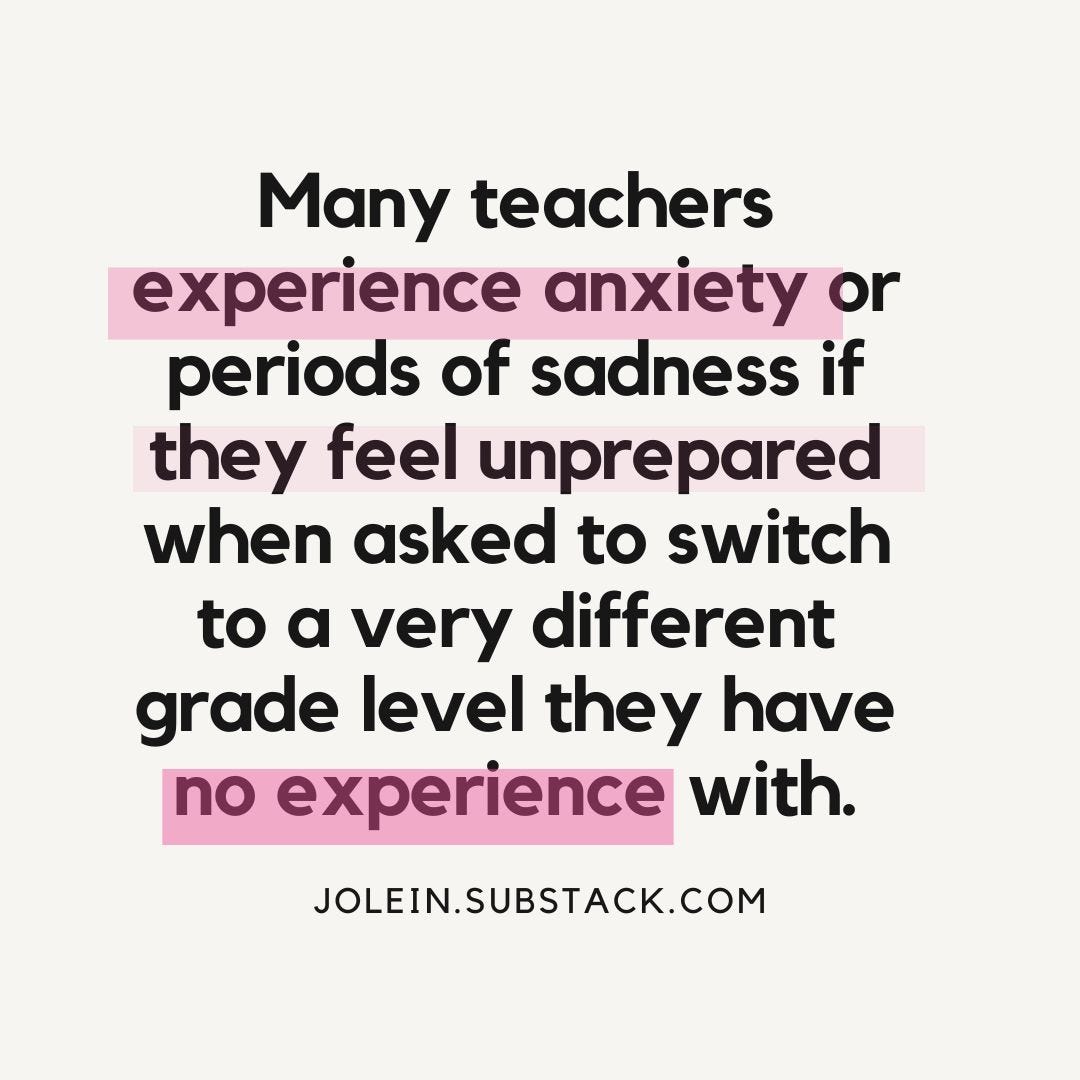The Position Change Conversation
Despite what we know about the impact on student learning, changing school conditions may result in a need for a position change. Here's how to have the conversation.
I remember the moment I felt like I was fired from my job as a teacher. Between my first and second years of teaching, I was returning from summer vacation with my parents. My brand new principal called, and I answered anxiously. “Ms. Mabee, you must move grade levels down to fifth grade. You will be self-contained.”
As with all first-year teachers’ experience, I went through the rock-crusher of a first year. While eager to take a well-deserved break, I knew I did not want to do that again. Moments of summer boredom were spent crafting carefully aligned (to the Bloom's level) assessments with perfectly manicured student trackers to match. I had nearly sequenced out nearly the entire year of sixth grade ELA and social studies objectives I could tell you what I was doing on February 10.
All that work, experience, planning, failures, and wins felt lost—all in that moment. It was like getting the wind knocked out of me. I am not even sure what I said next.
Position Changes
Each spring, school leaders engage in the critical, challenging, and somewhat tedious work of planning for the next school year. Resignations, budgets, and allocations feel like a demented game of Jenga. A single person deciding not to return from maternity leave can topple a tower that already has so many holes.
Changing teaching positions, whether within the same school or to a new school, is quite common, with around 40% of teachers doing so in a typical year. Each year in New York City, approximately 15% of teachers change grade levels or subjects within the same school, while another 21% switch schools, contributing to a high rate of "teacher churn.”1 Some teachers actively seek out new positions for a "fresh start" to combat burnout.2
Position changes directly impact student learning. Whether a teacher is new to teaching, new to the community, or new to a grade, any type of new tends to lower student achievement. The degree to which it lowers achievement depends on the type of switch.
“As for magnitude, the researchers estimated that getting a churned teacher is about a quarter of the size of being assigned a brand new teacher. So while not huge, the fact that it’s common means that over time, churn can add up to lost learning for students.”
(Sawchuk, S. Education Week).
Why Position Changes?
If we know that position changes do not positively impact student learning, why do schools consistently rely on this strategy?
Student Needs
If there are shifts in student demographics or needs within the school, such as an increase in English Language Learners or students requiring special education services, the principal may need to reassign teachers to better meet these needs. This ensures that teachers are placed where their expertise can significantly impact student learning.
Curricular or Requirement Changes
Sometimes, schools adopt new curricular programs or standards that require teachers to teach different subjects or grade levels. For example, schools may be legislated to teach newly adopted computer science standards, requiring schedule shifts, staffing needs, and student ratios.
Teacher Expertise and Development
Principals may consider reassigning teachers to new positions based on their expertise and professional development needs. For example, an aspiring school leader may require additional internship hours, affecting teaching time and student coverage. A principal may place a bet on a teacher by moving into a reading specialist position because of their skills in providing intervention.
Organizational Needs
Changes in the school's organizational structure, such as the creation of specialized programs or teams, may require teachers to take on different roles or responsibilities.
Staffing Adjustments
In some cases, budget constraints or enrollment fluctuations may necessitate staffing adjustments, leading to changes in teachers' positions or grade-level assignments.
Here’s a common and uncomfortable truth. Position changes often occur because we are too uncomfortable to give direct feedback. School leaders rely on wishful thinking rather than doing the work to coach someone to be more effective in their role. They wish that a teacher’s performance concerns were more of a fit challenge than a capacity issue.
Mixed Reactions to Position Changes
Teachers have mixed feelings about changing grade levels or positions within a school. Some teachers welcome the opportunity to take on a new challenge and continue developing their skills. Changing grade levels can be exciting for teachers to take on new challenges and push themselves to become better educators.3 It can provide a "fresh start" and help combat burnout.
However, many teachers resist being forced to change grade levels or positions. Like me, many teachers experience anxiety or periods of sadness if they feel unprepared when asked to switch to a very different grade level they have no experience with.4
Managing Position Changes
If you are the unlucky person who has to make tough decisions about people’s jobs in service of kids, consider the following when navigating teacher position changes:
Involve Teachers in the Process
Effective administrators seek teacher buy-in rather than imposing changes. Teachers are more likely to embrace changes they see as beneficial. Use your data.
Provide Support and Preparation Time
Switching to new grade levels can be anxiety-inducing without proper preparation. Ensure teachers have support and time to prepare for new roles, especially if they're significantly different
Leverage Teachers' Skills
Recognize teachers' skills like conflict resolution and instructional design, which transfer well to their new positions. Maximize their impact.
Communicate Transparently
Keep teachers informed to reduce speculation and boost morale. Clear communication fosters better engagement during transitions.
Minimize Frequent Changes
Avoid shuffling teachers too often, as it can signal instability, indecisiveness, and disorganization.
It feels like putting a puzzle together in front of a box fan, which can make doing these things uncomfortable. Push through the discomfort and communicate openly.
The Position Change Conversation
I don’t envy my principal, who had to make that phone call about my position change. She was new to the building and had to tell an immature 23-year-old overachiever she was moving positions. These conversations can be difficult, and fight-or-flight responses can be activated.
The Position Change Conversation PDF
Position Change Conversation
Begin with the Decision
Don’t hide the ball. Rip the Bandaid and let them know about the decision.
“After careful consideration, I have decided to change your responsibilities for next year.”
“I’m just going to come out and say it. You are moving positions next year.”
“I have some news that may cause some mixed emotions. Next year, you will serve as a <position> for our school.”
“Let me just begin by sharing the purpose of this meeting. Next year, I need you to take the role of <position> for our school for next year.”
Acknowledge Emotions
Acknowledging that this conversation may bring up various emotions for the teacher.
"I recognize that this change can be challenging."
"I understand that this decision may bring up mixed emotions for you."
"It's natural to feel uncertain or hesitant about changes like this."
“I understand that this decision may make you want to pursue other options."
“I know this may be a shock and will take some time to process.”
Express Understanding
Show understanding of the teacher's situation and concerns.
"I understand that this change may impact your daily routine and workload."
"I recognize that you may have concerns about how this will affect your current responsibilities."
“You are likely already thinking of your “to do” list and I want to assure you that we will take this one step at a time.”
“I want to acknowledge that this may cause some initial anxiety.”
Highlight Benefits
Emphasize any potential benefits or opportunities that the new position may offer, such as professional growth, new challenges, or alignment with the teacher's strengths and interests.
"I want to discuss how this new position can offer you opportunities for professional growth.”
"This change could provide you with new challenges that align with your strengths and interests."
“Looping will sustain the momentum that you have already built with your students.”
“You will have some great new opportunities in this new role.”
4. Listen and Validate
Allow the teacher to express their thoughts, concerns, and questions. Listen actively and validate their feelings to show that their perspective is valued.
"I'd like to hear your thoughts and concerns about this transition."
"Your perspective is important, and I want to make sure we address any questions you have."
“What is on your mind initially?”
“What feels top of mind as you think about this transition?”
5. Provide Support
Offer support regarding resources, training, or assistance to help the teacher transition smoothly into the new position. Address any specific needs, such as additional training or support from colleagues.
"We're here to support you with resources and training during this transition."
"Let me know if there are specific areas where you need additional support or guidance."
“You probably have a lot of questions. I want to assure you that you will have support every step of the way.”
“What are some of the things you feel you will need to be successful in this new role?”
6. Clarify Expectations
Clearly outline the expectations and responsibilities associated with the new position. Ensure that the teacher clearly understands what is expected and how they can succeed in their new role.
"I want to make sure you clearly understand the expectations for the new role."
“Here are the responsibilities and goals associated with the position so you know what to expect."
“I have included a job description. You can review it on your own.”
“It is critical that we are on the same page about what this role is and what the expectations will be.”
7. Follow-Up
Schedule a follow-up meeting to check in with the teacher after the initial conversation. This shows your ongoing support and commitment to their success in the new position.
"Let's schedule a follow-up meeting to check in and see how things are going."
"I want to make sure you feel supported as you settle into your new role, so we'll touch base again soon."
“I acknowledge that you may need some time to think about this. I will follow up with you in a few days. How does that sound?”
“Let’s take a few days to simmer and then come back to revisit this conversation. Specifically, I want to follow up on <issue brought up in the meeting>.”
Conclusion
Navigating teacher position changes is a delicate dance for administrators, impacting educators and students profoundly. Having been on the receiving end of such a change, I understand the challenges these conversations present. It's about pushing through discomfort and communicating openly to ensure a smoother transition for everyone involved.
Sawchuk, S. (2022a, February 25). What happens to student learning when teachers change positions in schools?. Education Week. https://www.edweek.org/leadership/what-happens-to-student-learning-when-teachers-change-positions-in-schools/2016/08
ProTeacher Community. (2017, March 11). How often do you transfer schools?. ProTeacher Community. https://proteacher.net/discussions/threads/how-often-do-you-transfer-schools.578231/
Little, L. (2020a, July 29). Changing grade levels: What to consider before making the Switch. Castle Software, Inc. https://www.castlelearning.com/news/news-changing-grade-levels-what-to-consider-before-making-the-switch/
Watson, A. (2021, November 16). Advice for teachers who are changing grade levels. Truth For Teachers. https://truthforteachers.com/changing-grade-levels/





